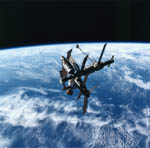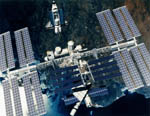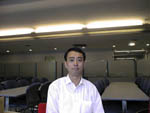|
|||||
 |
 |
| Human Body Phantom | International Cooperation |
|
|
 |
|
|
We interviewed Dr. Nakano, STS-91 Project Scientist of NASDA Space Utilization
Research Center. Dr. Nakano has been involved not only in STS-91 but also
in STS-79, 84, 89 which all conducted Space Radiation Environment Monitoring.
He was also involved in space experiments utilizing the Russian space station
Mir, conducted in February and August ,1997. The experiment themes of all
these missions are related to space radiation. We interviewed Dr. Nakano
primarily from the view point of international cooperation in this field
of these researches.
Q1.What does a Project Scientist do?
A1.As a project scientist, I am responsible for scientific experiments
of a specific mission. I am the NASDA contact point for researchers, and
also handle coordination for these experiments with NASA. In case of a
schedule change during a mission, I will make decisions on behalf of Japanese
Researchers as to what kind of countermeasures should be taken for that
matter.
Q2. How did NASDA become involved in these four cooperative experiments
with NASA, from STS-79 to STS-91?
A2. NASA invited NASDA to cooperate in development and evaluate
technologies to be utilized to mitigate the risks during the construction
and operation of the International Space Station.
Q3. What is NASDA's aim in this cooperative research?
A3. As the research target, NASDA has will develop technology for
space radiation environment monitoring, space radiation effect on living
organism and space weather forecast, which estimates space radiation inside
a spacecraft.
 |
| Space Station |
Q4. How does a cooperative research progress?
A4. Research missions should be conducted in a cooperative manner,
so we tried not to set similar themes or not to select similar specimens,
and we share technologies and materials. We also compare the results of
experiments, or there are even cases of writing papers cooperatively.
Q5. Could you give us examples of technologies developed in Japan?
A5. There are two methodologies in researching radiation, the passive
method and the active method. The passive method uses dosimeters, and analysis
will be done after certain period of time has elapsed. This is a very popular
method which gives researchers a total radiation dose of the time period
of exposure. The active method converts radiation into electric signals,
and allows researchers to monitor radiation in real time, which is a Japanese
unique technology. The equipment designed for this experiment is called
Real-time Radiation Monitoring Device (RRMD). Since RRMD allows time sequential
radiation monitoring, radiation in relation to the surrounding condition
can be acquired, and it shows us the possibility of radiation estimation
as well.
There is also a neutron monitoring device called the Bonner Ball Neutron
Detector (BBND). This is the first experiment hardware in the world to
monitor neutron inside a spacecraft. We used silkworm egg for the first
time, too. Japan has a considerable amount of solid data on silkworm, which
gives us basic foundation to research the radiation effect on silkworm
heredity. We are also interested in developing personal dosimeter for the
future use. In order to acquire accurate radiation dose of each astronaut
and to utilize it for each one's health management, small and light weighted
dosimeter with wide range of radiation detection capability is essential.
Japan is now working hard trying to find out the ideal combination of radiation
detective materials for this purpose.
Q6. Have you utilized data offered from Russia?
A6. Yes we did. Russian data are obtained in a passive manner whereas
we take an active method, however they give us good influences on our activities.
Through the results of cooperative experiments to this date have shown
that data from both Russia and the US have similar inclinations, and there
are no contradictions among them. Based on this fact, NASDA is working
to acquire time sequential data by taking the active method.
Q7. How will the results of these experiments be reflected to the International
Space Station (ISS) project?
A7. Domestically, the results will be utilized to establish health
management criteria against radiation dose effect. In the ISS project,
these results will be submitted to a committee composed of specialists
from various countries and will be discussed for setting up radiation dose
management criteria for the ISS.
 |
| Dr. Nakano |
Q8. Please tell us about joint projects between Japan and Russia that
you have been involved in.
A8. We had two opportunities of space experiments in February and
in August in 1997 utilizing the Russian space station Mir. We conducted
space radiation related experiments, and we also picked and analyzed microorganisms
inside the Mir which is the only one facility in the world operated on
orbit for long duration. As to microorganisms, the results of the experiment
conducted in February indicated that no disease germ has been found and
that radiation resistant microorganism was found, and also that many kinds
of microorganisms those had not been identified till then were found. We
intend to proceed to molecular level research of damaged DNA repair mechanism
which may have something to do with radiation resistant characteristics
of microorganism. We expect that the results of this research might contribute
to the effort for developing cancer curing medical procedure.
Q9. What are the plans for the future corporation?
A9. Since Russia and Japan looks forward to continuing this corporation,
I understand this relation in the future as well. Maybe Japanese engineers
will be stationed in Russia for astronauts training.
Q10. What is your impression you received from the activities between
Japan and Russia?
A10. When you negotiate with Russia, personal relationship is much
more vital than in the case with US. Through many experiences, I learned
that Russia has a cultural and mental background that without personal
relationship it is very hard to establish actual cooperative relationship
between the two countries.
Dr. Nakano was very busy preparing for the launch of STS-91 scheduled only a few days after this interview. Nevertheless he was very willing and kind to answer our questions. As soon as the interview ended, he stood up saying "I have to pack my bags. I am leaving for Houston tomorrow." Thank you for your cooperation, Dr. Nakano!!
Last Updated : June 11, 1998
| Human Body Phantom | International Cooperation |

|